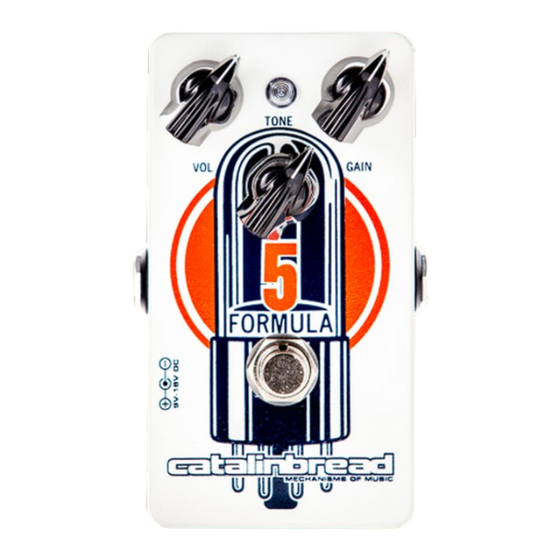
Advertisement
FORMULA NO. 5 USER GUIDE
INTRODUCTION
The Catalinbread Formula No. 5 was inspired by the old tweed amps from the 1950's, most notably
the 5E3 circuit. The character of the 5E3 is very unique. It has very minimal power filtering, low plate
voltages, elemental tone stack, and does next to nothing to control the low end between gain
stages, not to mention the under-rated output transformer and speaker. The entire system runs
inefficiently resulting in a loose bass, greasy mids, cutting treble, and incredible grit – none of these
qualities were ideal or intentional back in the day. In spite of this, over the past five decades the amp
inspired some of the coolest, most sought after guitar tones ever recorded. It's practically a fuzz
pedal with a built-in speaker!
We've captured the unique qualities of these amps in the Formula No. 5. For this circuit we felt
cascaded JFET gain stages yielded the most authentic sounding result. They have a softer sound
than MOSFETs. JFETs also have much more natural attack/decay behavior than diode clipped rigs
which are pingy on the attack and fizzy on the decay. We chose capacitor types that enhanced the
midrange and burnished the treble. And perhaps most importantly, we paid specific attention to the
input sensitivity of circuit so that it feels and behaves just like the amp it is seeking to emulate. The
attack characteristic at the pick, the clean up at your guitar's volume knob - all of these things are
absolutely crucial to capturing the 5E3 vibe and when combined make for a very dynamically
sensitive playing experience.
Advertisement
Table of Contents

Summary of Contents for Catalinbread Formula No. 5
- Page 1 It’s practically a fuzz pedal with a built-in speaker! We’ve captured the unique qualities of these amps in the Formula No. 5. For this circuit we felt cascaded JFET gain stages yielded the most authentic sounding result. They have a softer sound than MOSFETs.
- Page 2 The amp was set up and forgotten about - you did everything at the guitar. That is also the best approach for using the Formula No. 5 - set and forget and work your guitar controls. Simple is better!
-
Page 3: Quick Start
Oh and a quick word about powering your Formula No. 5 - it will behave differently depending on the power source, this is intentional and we feel a very cool benefit! With a 9v battery, you will experience the most ‘sag’... - Page 4 GUITARS Like the actual amp, the Formula No. 5 is responsive to the type of guitar you’re playing into it. If you’re playing vintage style Fender guitars, you’ll get the classic Fender into Fender tone and the tone will stay cleaner longer as you turn up the Gain knob.
- Page 5 - you aren’t adding more distortion to them. The Formula No. 5 LOVES being hit by fuzzes and boosts! Just like the amp that inspired it! With some good fuzzes and boosts, you’ll be able to take the FN5 from vintage roots...
-
Page 6: Power Supply
POWER SUPPLY You can power your Formula No. 5 with any quality power supply designed for use with effects pedals. The output should be a negative tip DC from 9 to 18 volts. If you want more volume, headroom, and percussive attack, try running an 18 volt power supply. A 9 volt power supply will have a slightly softer sound that saturates more easily - it's sort of like the difference between a 50 watt and 100 watt amp! Definitely try it on 18 volts though - there's...



Need help?
Do you have a question about the Formula No. 5 and is the answer not in the manual?
Questions and answers